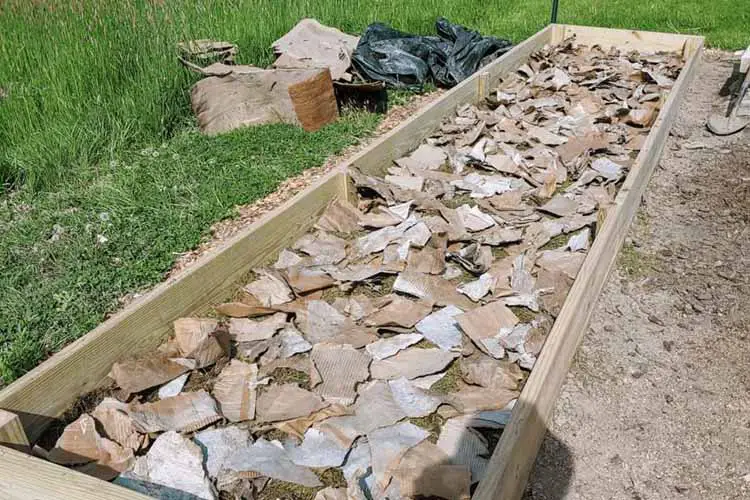If you’re considering adding a load of cardboard to your compost pile, you may be wondering what the most effective way of shredding it is.
In this article, I cover 5 different ways of shredding cardboard for compost, including:
- Using a box cutter (great for small amounts of cardboard)
- Using an electric cutter or box saw
- Using a heavy-duty office shredder
- Using a chipper shredder (great for people with serious amounts of cardboard)
- Using the ‘soak and shred’ method to aid the process
I also cover ways you can use cardboard when composting without having to shred it. These include:
- Using the cardboard as mulch (i.e. lasagna composting)
- Using cardboard as an insulator for your compost pile
- Using cardboard as a makeshift worm blanket (perfect for vermicomposters)
Ready? Let’s jump right in.
What’s the best way of shredding cardboard for compost? The best way to shred cardboard for compost is with a heavy-duty office shredder. Ensure all staples and plastic are removed from the cardboard. Fold the cardboard flat and ensure that the width does not exceed that of the shredder. Opt for a shredder with at least a 12 sheet capacity.
How to shred cardboard for compost
Before you do any shredding, look for any plastic on your cardboard and remove it.
Tape and stickers are mostly what you’re looking for (although did you know that Amazon’s black tape is compostable?!).
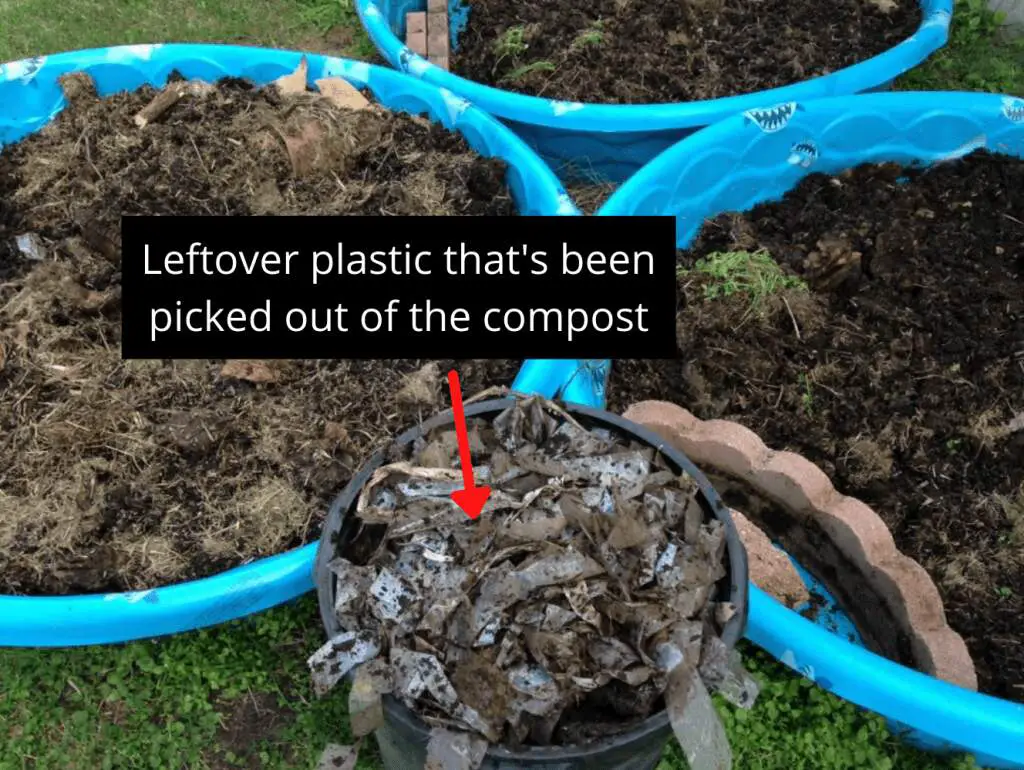
Plastic won’t degrade in your compost bin, and if you’ve shredded it all into tiny pieces it will be a NIGHTMARE to pick out.
If the plastic goes in whole, then it’ll be easier to pick out. Some people decide to leave the bits of cardboard with tape on in-tact and then just sift the tape out before using the compost.
Also, decide how small you want the pieces to be. The smaller you shred the cardboard, the faster it will decompose.
Use a box cutter

If your weapon of choice at the moment is scissors (or worse, your hands), you need to upgrade to a box cutter.
A box cutter is basically a very sharp knife that can slice through cardboard with ease.
This method is still pretty manual so isn’t a long term solution.
But if you just have a one-off load of cardboard that you need shredded now, a box cutter is easy to get hold of and requires much less effort than scissors.
If you have corrugated cardboard, make sure to cut along the corrugation – this will make your life 100x easier.
To make your life 200x easier, wet the cardboard. This will soften the cardboard and mean it’s easier to cut it.
Use an electric cutter/circular saw/band saw

The next step up from a box cutter is an electric box cutter.
An electric cutter takes away the manual work and makes light work of a couple of sheets of cardboard.
I like the WORX ZipSnip electric cutter because it’s lightweight, easy to maneuver, and has an in-built sharpening system (so the blade never gets dull).
To get even more extreme, you could invest in a band saw, a mini chainsaw, or a circular saw. These tools will be able to cut through multiple layers of thick cardboard at a time and you’ll get nice even shreds.
Simply pile up your cardboard, secure it by placing something heavy on each end, and get sawing!
Always wear a face mask and eye protection if you’re using an electric saw. They can create a fair amount of sawdust, or worse, send small shards of cardboard flying at your face.
Who knew ripping up a bit of cardboard could get dangerous?!
Use a heavy-duty office shredder
If you have a steady supply of cardboard and are looking for a long-term solution, a good option is to get a machine that can do the job for you.
Will paper shredders shred cardboard?
Paper shredders will shred cardboard as long as you opt for a heavy-duty model. A 12 sheet shredder is the minimum size I would look at getting, but an 18 or 24 sheet shredder would be better, especially if you want to shred lots of thick corrugated cardboard.
Amazon basics shredders go all the way up to 24 sheets.
The more powerful the shredder, the longer run-time it will have too. For example, an Amazon basics 12-sheet shredder can only run for 7 minutes continuously before needing to cool down. Their 24 sheer shredders can run for 40 minutes.
Another brand I recommend is Bonsaii. Their 18-sheet shredder can handle cardboard with zero problems, and it has a runtime of 60 minutes. It’s also nice and quiet running at 62 dB, which is about the same level as a normal conversation.
It’s very important that you get a paper shredder that’s up to the job. Not all of them will be able to handle cardboard.
A cheap, 6-sheet shredder might be able to do a few bits of thin cardboard, but it’s going to overheat pretty quickly. Not ideal when you have a massive pile to get through.
An 8-sheet will do a bit better, but won’t be able to handle prolonged cardboard cutting. Hence the 12-sheet minimum recommendation.
Wetting and drying the cardboard a few times will weaken it and put less stress on your shredder.
You also need to pick between cross-cut and micro-cut shredders. Micro-cut shredders produce smaller shreds but are typically more expensive.
For most composters, cross-cut shredders are sufficient (or even preferred) because the micro-shreds lose most of their ‘fluffing’ ability. Larger shreds help to add structure to your compost.
There are also strip-cut shredders, but these have lost popularity recently so there are fewer of them around.
One downside to paper shredders is that you still need to rip/cut the cardboard up into paper-sized sheets to be able to fit into the shredder. Although a box cutter or an electric cutter will help massively with this!
I like to turn my TV up to full volume, put on my favorite show and watch it while shredding through the cardboard. It’s surprisingly therapeutic.
Use a chipper shredder
Chipper shredders may seem like overkill at first, but this does completely depend on the volume of cardboard (and other materials) you plan on adding to your compost. Chipper shredders also make light work of twigs, leaves*, branches, pine needles and other garden waste.
*Only certain chipper shredders are capable of shredding leaves.
Will chipper shredders shred cardboard?
Chipper shredders can shred cardboard and are great for industrial-strength cardboard that won’t go through a paper shredder. However, softer cardboard is at high risk of clogging in a chipper shredder so you have to be careful.
Make sure the cardboard is dry, feed the machine slowly and roll the cardboard up so it’s in the shape of a stick.
If you start to notice any clogs, stop the chipper immediately and rectify the blockage before shredding again.
Good chipper shredders aren’t cheap, so I wouldn’t advise getting one just for shredding cardboard. But if you have a lot of twigs or branches you also want shredded, they’re a worthwhile investment.
The best chipper shredder brand is Patriot. It’s more pricey than some, but you’re paying for quality.
Their products are made in the USA unlike most other chipper shredder brands which are made in China.
They have an electric model or a more powerful gas one. The electric model will be fine for cardboard.
If you need some more convincing, here’s a video of it shredding cardboard:
Before you shred any cardboard in a chipper shredder, make sure you’ve taken any metal pieces out (e.g. staples). These can wreak havoc with the blades.
Considering investing in a chipper shredder? Make sure to check out my detailed guide on The Best Chipper Shredders For Composting.
Soak the cardboard and then shred it manually
Soaking large pieces of cardboard in water makes them way easier to shred.
The longer you soak them, the easier they’ll be to shred.
Soak them for long enough and they’ll fall apart in your hands.
If you live in a wet climate, you can simply leave the cardboard in a pile outside and let the rain work its magic. After a few bouts of rain, the cardboard will be soaked through and you can start ripping it up.
Or you can find a large container (I use my bathtub), fill it with water, and put the cardboard in. Make sure the water completely covers the cardboard.
If you’ve got strong, corrugated cardboard, I recommend soaking it at least overnight, but preferably for 48 hours or more. For thinner cardboard, overnight should be sufficient.
But if you only have a few hours – this is still better than nothing!
Once the cardboard has been soaked, you can either start shredding it by hand or get a tool to help you.
A garden pitchfork is great, you can swirl it around in the water-cardboard mixture and the cardboard will start breaking up.
If you want something less manual, this guy uses a drill with a paint mixer attached.
Another advantage of soaking cardboard is that it makes coloured coatings and tape really easy to peel off.
Things like cereal boxes have a thin decorative coating on them. Most people avoid composting them due to concerns around chemicals or them being waterproof. After 30 minutes or so of soaking, these coatings peel off really easily, leaving behind plain cardboard.
Do I need to dry the cardboard after soaking it?
This is totally up to you. If you want the cardboard to help soak up excess moisture in your compost, it’s a good idea to let it dry out first. But if you think your bin could benefit from a little extra moisture, it’s best not to dry the cardboard out.
I would always at least ring to cardboard out (or stamp on it) to make sure it’s not dripping wet. That said, a healthy compost pile should be able to handle a bit of wet cardboard.
The same goes for worm bins. Moist cardboard bedding can help reduce how often you need to add water to the bin, but if the bin is already running wet you don’t want to add more moisture in.
Ways to compost cardboard without shredding it
If all this sounds like too much hassle, there are ways to compost your cardboard without shredding it first.
Here are two ideas.
Use it as mulch / in lasagne composting
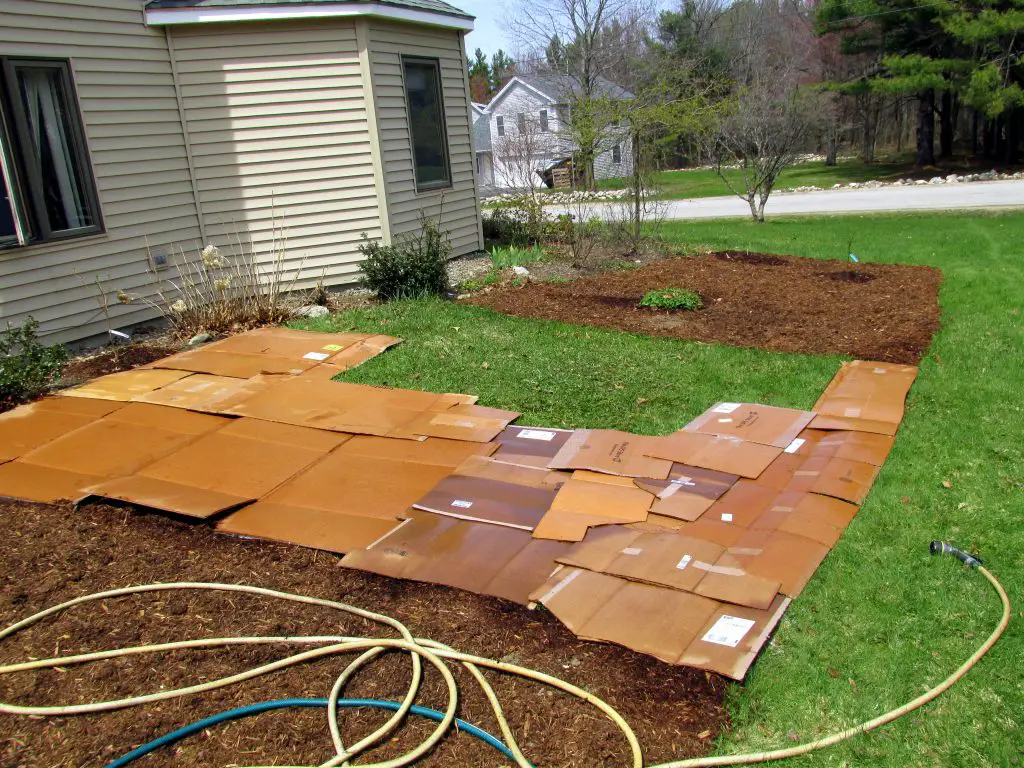
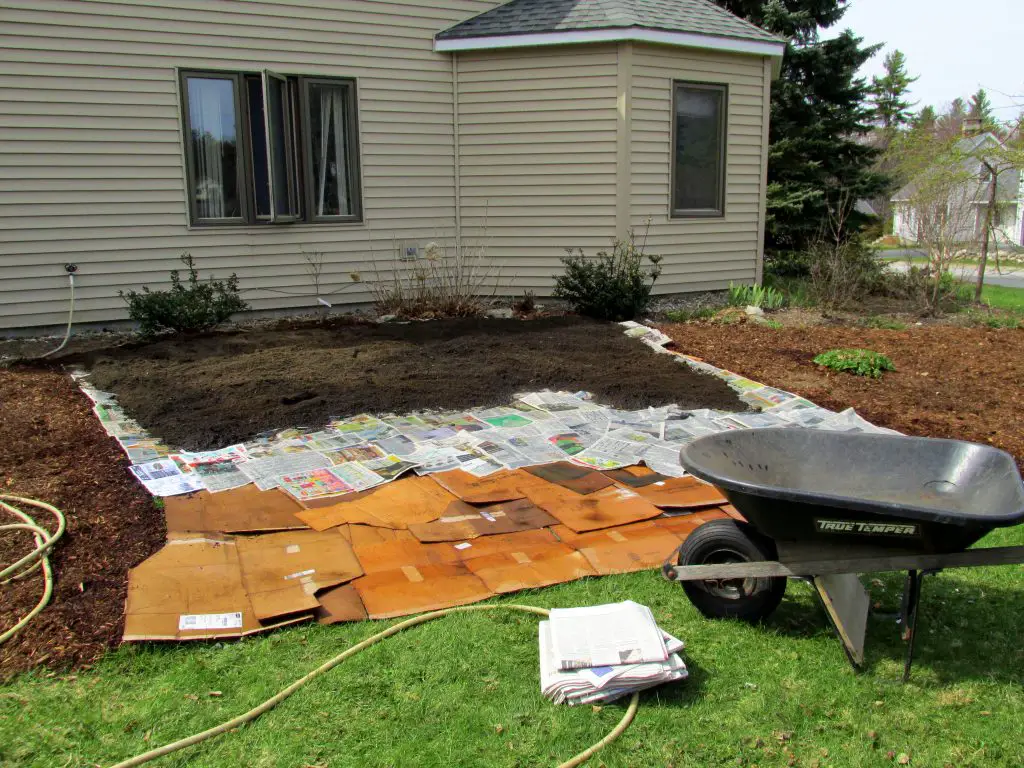
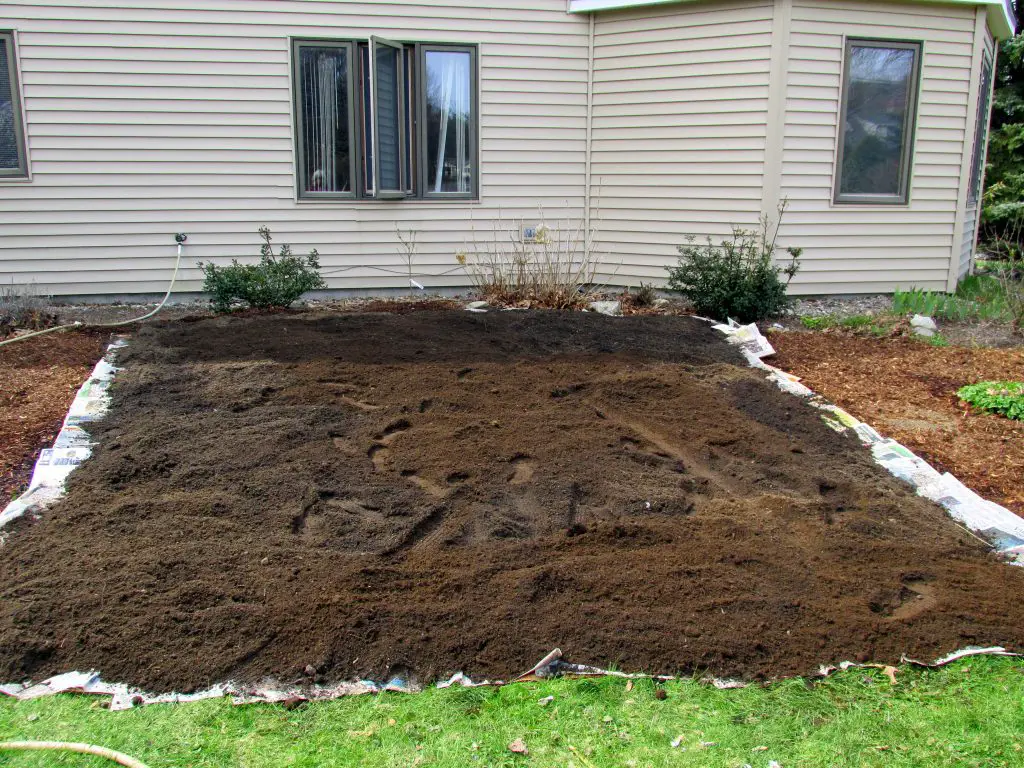
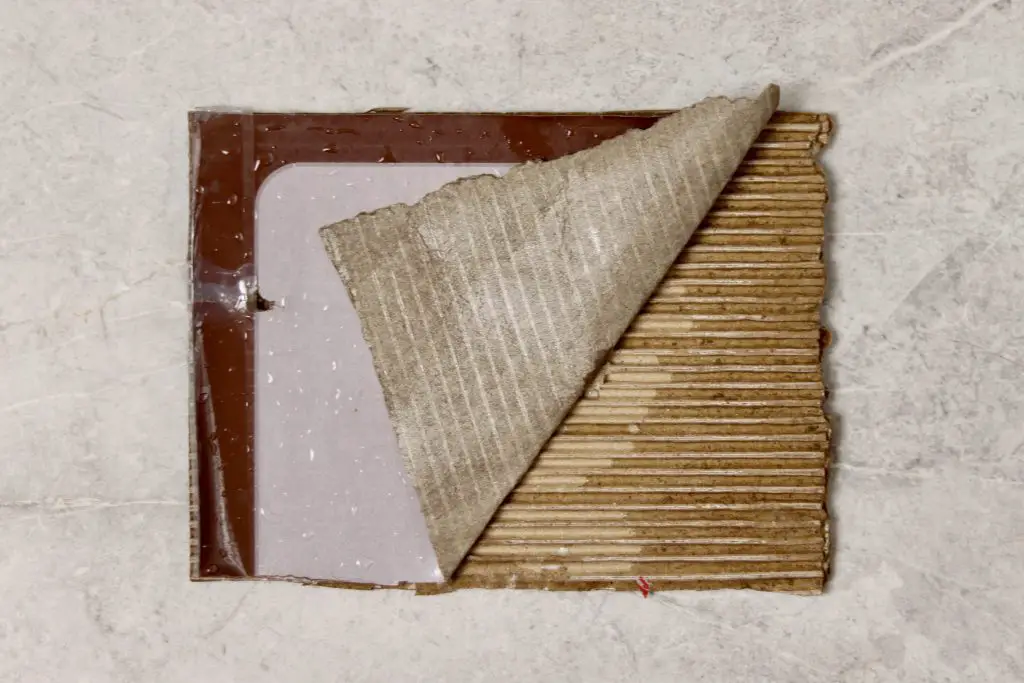
Sheet mulching or lasagne composting is a popular gardening technique for creating healthy soil out of barren land, or converting a lawn into a planting area.
The idea behind it is simple, you build up layers of organic materials and then these layers decompose and turn into compost. Worms then work to integrate that compost into the soil, and in the end, you’re left with nutrient-rich, well-structured soil that’s perfect for planting.
Cardboard is often used as the first layer in sheet mulching because it is a brilliant weed barrier. The cardboard starves the weeds (and any grass) of sunlight and stops them from growing.
Cardboard also massively helps with water retention which helps cut down on watering.
At a minimum, you need enough cardboard to cover the area you’re looking to mulch and enough organic matter to cover the cardboard. You can use any organic matter you want:
- Finished compost
- Wood chips
- Straw
- Dry leaves
- Animal bedding
Are all good options.
Cardboard followed by mulch is a simple setup. You can add many more layers and additives to make it more complicated, but that’s a whole other article in itself.
To use cardboard in sheet mulching:
Water the area before you apply any cardboard, and also wet the cardboard once it’s laid. The moisture helps weigh the cardboard down so it stays in place, and also speeds up decomposition.
When you lay the cardboard, make sure to overlap each piece by a couple of inches to ensure that there’s no gaps.
Avoid using coated cardboard for sheet mulching because the plastic can act as a water barrier and stop water from reaching the soil below.
Use the cardboard to insulate your compost bin
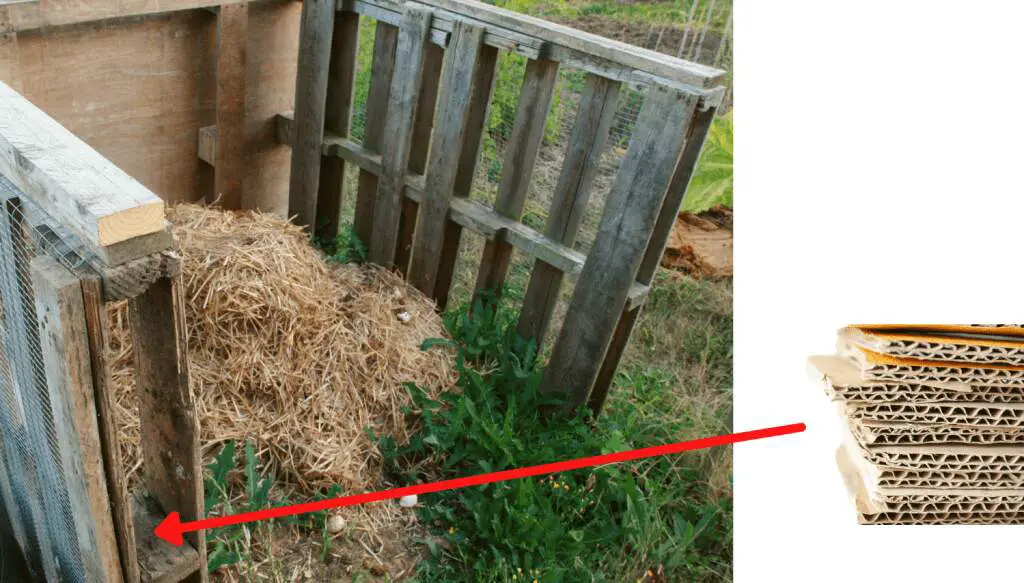
Insulating your pile is important during colder months. It’s also important if you’re trying to hot compost, as it keeps the heat within the pile.
Heat helps compost decompose faster. If there’s enough heat, you also kill all the weed seeds in your compost.
Corrugated cardboard makes an efficient insulator because the fluted design traps air within the cardboard. The trapped air reduces heat transfer.
Simply cover your pile with a layer of corrugated cardboard, or line your compost bin with a few sheets. Overtime, as the cardboard is exposed to the elements, it will start to break down and you’ll be able to easily mix it into your pile and replace it with fresh cardboard.
Corrugated cardboard is the best cardboard for insulating, but you can use whatever cardboard you have available.
If you have an open pile, covering the compost with cardboard can also help reduce moisture evaporation. This will mean you don’t have to water the pile as much.
Use the cardboard as a worm blanket
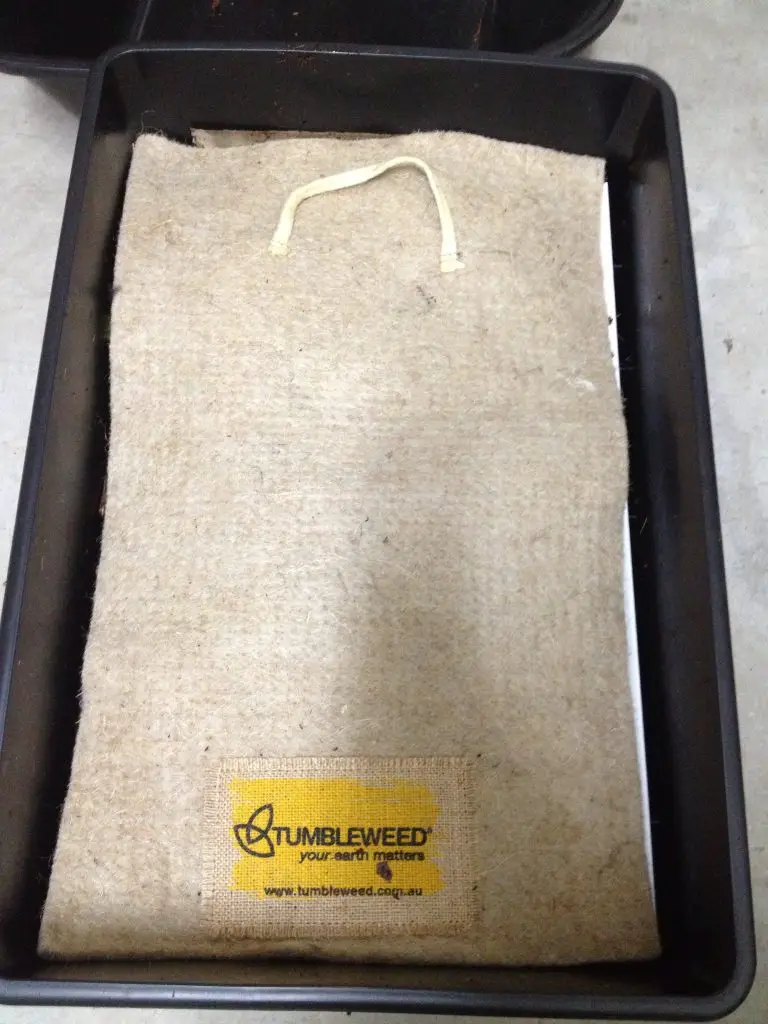
Worm blankets help keep moisture in your bin and block light out. This means you don’t need to water the bin as often, and the worms will be happier.
Traditional worm blankets are made from burlap, but cardboard makes a good alternative.
Simply cut a piece of cardboard into the shape of your worm bin and lay it on top of the bedding.
The worms will eventually eat the cardboard, so you’ll have to replace it every few months.
Are all types of cardboard suitable for composting?
You can compost most cardboard, both flat and corrugated are fine. The only cardboard you need to be wary of composting is plastic-coated cardboard. Frozen food boxes, milk cartons, and paper cups are often lined with plastic to stop them from leaking. Plastic won’t degrade in a compost bin.

A trick I mentioned earlier is to soak the coated cardboard in water. This loosens the coating and makes it easy to peel off. You can then compost the plain cardboard.
You can also get wax coated cardboard although this is more rare.
Wax-coated cardboard is okay to compost, but it’ll be very slow and it’s often impossible to tell if the cardboard has a wax or plastic coating! One test is to scrape it with your fingernail, wax coatings tend to scratch more.
People are often wary of composting colored cardboard due to concerns about chemicals in the ink. However, these concerns are mostly unwarranted. In the past, inks were petroleum-based and toxic, but now most inks are soy-based. Soy inks are both cheaper and better for the environment.
Soy-based inks pose no problem for a compost bin.
Another common concern is around glue, but again, these glues are normally starch-based and therefore non-toxic. In fact, worms favorite type of cardboard is corrugated cardboard because they LOVE the glue.

Lastly, greasy cardboard can become a nuisance if you add too much. This is especially true in worm bins.
Oils slow down the composting process, attract pests, and smell NASTY. A small amount of grease on a leftover pizza box will be okay, but 20 oil-soaked boxes in a small bin will upset the balance.
If you can recycle the cardboard, you should aim to do this instead of composting it. Recycling cardboard helps to reduce the use of natural resources (virgin trees).
Do you really need to shred cardboard for composting?
Shredding cardboard for compost is preferred because it prevents sheets of cardboard matting together and creating air/water barriers in the compost. If air can’t move around the pile properly, your compost may turn anaerobic. Shredded cardboard also decomposes much faster than a whole sheet.
However, if you have a large compost pile and you’re only adding a small amount of cardboard, then ripping it into a few pieces will be sufficient. Slightly larger bits of corrugated cardboard can sometimes be useful for a compost pile because they build structure and encourage good airflow.
If you don’t want to shred or rip the cardboard up, then you can use it as insulation or rain protection for your pile.
Do you really need to shred cardboard for a worm bin?
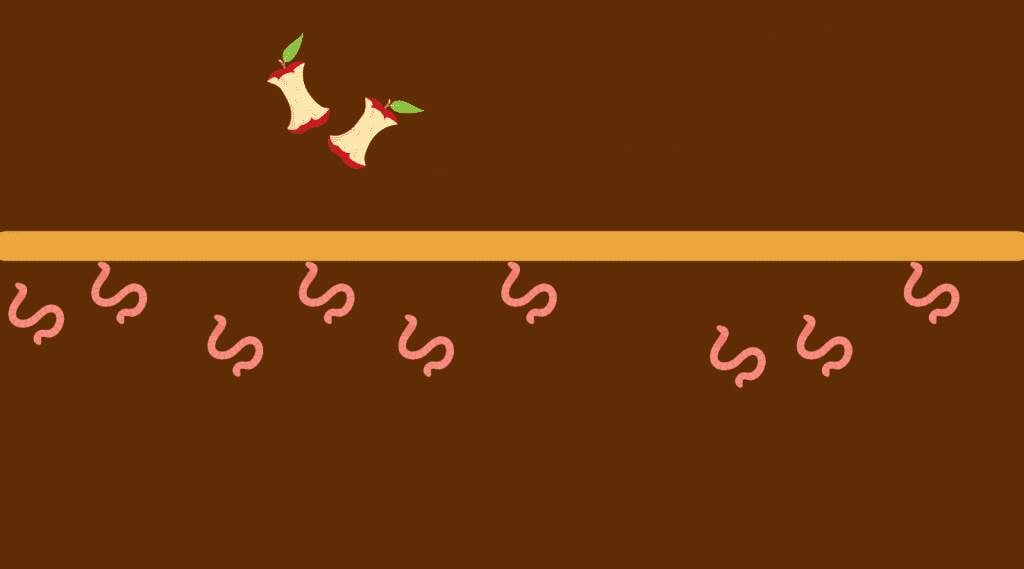
Large sheets of cardboard in a worm bin can hinder the movement of the worms and prevent proper drainage. It’s much better to shred your cardboard before putting it in a worm bin. If you want to use cardboard in your worm bin without shredding it, then use it as a blanket on top of the bin.
Corrugated cardboard is best for a worm bin because the ‘flutes’ help to keep the bedding fluffy and ensure good airflow.
